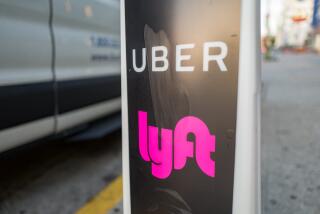Lyft exceeds estimates, forecasts shrinking losses for the year
- Share via
Lyft Inc. reported a second-quarter loss and sales that were better than analysts expected as the company boosted its forecast for the year, sending the stock soaring in after-hours trading.
The ride-hailing company now projects at least $3.47 billion in sales for the year, compared with an average analyst estimate of $3.32 billion, according to data compiled by Bloomberg.
While sales growth is slowing, it’s doing so less rapidly than previously anticipated. Revenue in the second quarter reached $867.3 million, up 72% from the year before. Analysts had expected 60% growth. The rate in the last two quarters was about 95%.
Lyft also improved its forecast for adjusted losses, which excludes debt, interest and other costs. Lyft said the loss for the year will be as much as $875 million, a $300-million decrease from an earlier projection. It would mean Lyft will lose less this year than in 2018.
Investors are measuring the San Francisco-based company against a period of massive growth over recent years, when it gained on Uber Technologies Inc. Lyft’s larger rival reports its own financial results Thursday. Both stocks trade below the price at which they went public this year. Lyft shot up as much as 13% in extended trading after the financial report, boosting the stock to heights it hasn’t seen since the initial weeks of trading.
Wall Street remains optimistic about the companies’ prospects despite persistent losses. Most analysts have buy ratings for the stocks. Lyft and Uber investors are betting they can upend the transportation industry and eventually find a path to profitability.
Both companies recently began to raise fares around the U.S., which is a main battleground accounting for almost all of Lyft’s sales. The price increases should help narrow losses. Lyft’s second-quarter loss increased 12% to $197 million. For the third quarter, it projects a reduction of as much as 29%, at $190 million to $210 million. “The price adjustments that have been reported went into effect at the very end of June, so there was limited impact in Q2,” Brian Roberts, Lyft’s chief financial officer, said in a phone interview.
Investors will watch closely whether Lyft can continue to cut costs while maintaining revenue growth. “We’re trying to get a sense that the unit economics in ride-sharing are good and that we’re not going to have to wait forever for some realization of profitability,” said Tom White, an analyst at D.A. Davidson.
The financial report follows news last week that Lyft’s chief operating officer, Jon McNeill, was leaving after less than two years. The company provided few details about the reason for his departure. Lyft is currently facing public scrutiny over the safety of its service after the Washington Post and NBC’s “Today” show reported on allegations of harassment from female customers. Recent news raises questions about Lyft’s ability to differentiate from Uber, which has long struggled to retain high-profile executives and fend off criticism that it doesn’t do enough to ensure rides are safe.
For Lyft’s critics, there are still warning signs. When accounting for stock-based compensation, insurance costs and other expenses, Lyft’s net loss in the second quarter worsened to $644.2 million, from $178.9 million a year earlier. Lyft reported a $1.14-billion net loss in the first quarter, which was largely due to costs associated with the initial public offering in March.
Analysts hadn’t foreseen that Lyft would post another big net loss last quarter. They typically focus on Lyft’s adjusted figures, concluding that those numbers provide a better indication of the business’ long-term trajectory.
Newcomer writes for Bloomberg.
More to Read
Inside the business of entertainment
The Wide Shot brings you news, analysis and insights on everything from streaming wars to production — and what it all means for the future.
You may occasionally receive promotional content from the Los Angeles Times.









